Culture of Angola
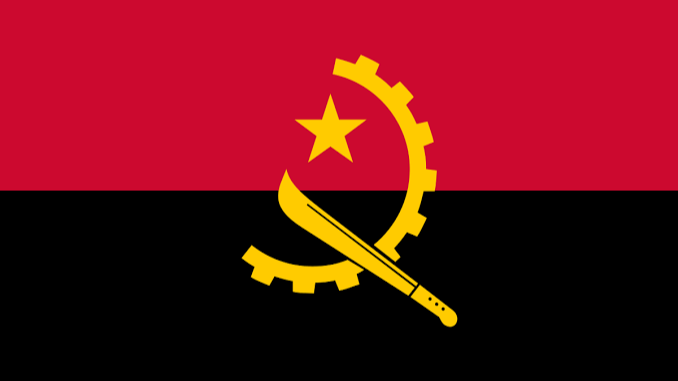
Culture Name
Angolan
Orientation
Identification. The word "Angola" derives from the title used by the rulers of the Ndongo state. The title ngola was first mentioned in Portuguese writings in the sixteenth century. A Portuguese colony founded on the coast in 1575 also came to be known as Angola. At the end of the nineteenth century, the name was given to a much larger territory that was envisaged to come under Portuguese influence. These plans materialized slowly; not until the beginning of the twentieth century did Portuguese colonialism reach the borders of present-day Angola. In 1975, this area became an independent country under the name República Popular de Angola (People's Republic of Angola). Later the "Popular" was dropped.
Angola may not classify as either a country or a culture. Since 1961, war has destroyed cultural institutions, forced people to flee, and divided the territory between the belligerent. Thus one cannot speak of a single national culture. It is difficult to obtain reliable information because the war precludes research in many areas.
Location and Geography. Angola is a country of 482,625 square miles (approximately 1.25 million square kilometers) in western Africa, south of the Equator. There are great variations in climate and geography, including rain forests in the north, drier coastal lands, the fertile central highlands, sandy soils in the east, and desert zones in the Kunene (Cuene) and Kuando Kubango provinces. Apart from large rivers such as the Zaire, Kwanza (Cuanza), Kunene, Kubango (Cubango), Zambezi, and Kuando, there are many smaller rivers, some of which are not perennial. The climate is characterized by a rainy season and a dry season whose timing and intensity differ in the various regions. Angola borders Namibia to the south, the Atlantic Ocean to the west, Zambia to the east, and the Republic of Congo to the north. The oil-rich enclave of Cabinda lies north of the Zaire river.
Demography. Because of the ongoing war, it is difficult to obtain reliable population figures. Also, the numbers fluctuate as people attempt to flee when the fighting is intense and return when the fighting has calmed down. It is estimated that in May 2000, 350,700 Angolans lived outside the country and another 2.5 million to 4 million were displaced within the national borders. About a million residents have died because of the war. Nonetheless the population has increased considerably. In 1973 there were 5.6 million residents; by 1992 that number had risen to 12.7 million. Despite a high annual growth rate, in the beginning of 2000 the population was estimated at 12.6 million. Since a census has not been held since 1970, the figures are difficult to evaluate. Angola has a young population, over 45 percent of which is below fifteen years of age. The population density varies greatly by region. Over the years, the urban population has grown strongly and more than half the people now live in towns. The capital, Luanda, has drawn in many immigrants—a quarter of all residents now live there.
Linguistic Affiliation. The official language is Portuguese. Many Angolans are bilingual, speaking Portuguese and one or several African languages. In nearly all cases this is a Bantu language; those speaking a Khoisan language number less than 6,000. Six of the Bantu languages were selected as national languages: Chokwe, Kikongo, Kimbundo, Mbunda, Oxikuanyama, and Umbundu. Many people are able to understand one or more of the national languages, but some forty languages are spoken.
Symbolism. The political culture is highly militarized, and in both the National Union for the Total
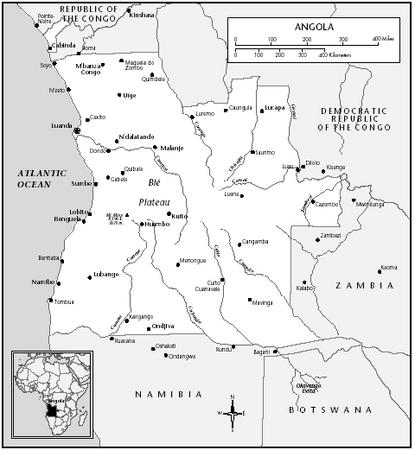
Angola
Liberation of Angola (UNITA) and the Popular Movement for the Liberation of Angola (MPLA) many symbols stem from the military tradition. Parades, uniforms, and flags are prominent during many political meetings. The national flag is red and black with a yellow machete, a star, and a cogwheel segment. UNITA is symbolized by a crowing cockerel.
History and Ethnic Relations
Emergence of the Nation. Present-day Angola is a construct designed by European politicians at the Conference of Berlin in 1885. Before that time, the area was inhabited by people with different political traditions, ranging from decentralized mobile groups to autocratic kingdoms. The Kongo, Ndongo, and Ovimbundu kingdoms had early contact with the Portuguese, who in the sixteenth century created colonies on the coast. Wars fought against the immigrant Portuguese, such as that waged by Queen Njinga of the Ndongo kingdom, often have been interpreted in a nationalistic framework. For centuries the communities in this area were affected by the Atlantic slave trade. Portuguese, mestiço, (person of mixed descent) and African merchants and middle men sold millions of slaves who were transported to the Americas on Dutch and Portuguese vessels. Although the slave trade was stopped in the 1880s, internal slavery continued into the twentieth century. After the Conference of Berlin, Portuguese colonialism took on a very different character. Through a slow and halting process that met with much local resistance, the Portuguese attempted to expand their control over the interior of the country and enforce a colonial system with taxation and forced labor. After the installation of autocratic rule in Portugal, repression in the colonies became even worse than in the past. The legacy of the colonial divide-and-rule tactics is still felt.
The war for liberation started in 1961 with rebellions in Luanda and the northern region. The anticolonial war ended after Portuguese soldiers, tired of war in the colonial territories, staged a coup in Portugal in 1974. On 11 November 1975, Angola became an independent country. Before that date, fighting had broken out between the three major nationalist parties: the National Front for the Liberation of Angola (FNLA), MPLA, and UNITA. After independence, UNITA received support from South African troops and was later backed by the United States, while the MPLA came to depend largely on Russian and Cuban aid. This division runs through the country's recent history. With Angola's involvement in the war in the Congo and with that war spilling into Namibia and Zambia, the war has taken on international dimensions.
National Identity. There is no single national identity. The country is divided along many lines: Ethnic, religious, regional, racial, and other factors interact in the conflict. However, the notion of being Angolan is strong. The Portuguese language sets Angola apart from its neighboring countries and has created long-standing ties not only with Portugal but also with Brazil, Mozambique, and other Portuguese-speaking countries.
Ethnic Relations. The civil war is often explained in ethnic terms, with the FNLA considered a Kongo party, the MPLA predominantly Mbundu, and UNITA dependent on Ovimbundu support. The stress on ethnicity is growing in intensity, and ethnic differences have become more important. However, many other factors play a role, and ethnicity is only one aspect of identity for Angolan people. Differences between rural and urban populations, regions, religions, and races are some of the criteria on which people classify themselves or are classified by others. The importance of clan as a factor in the construction of identity is disappearing rapidly. Although the small Khoisan-speaking minority is not discriminated against by law, its position is extremely difficult and these people are marginalized in many respects. The closely interlinked political, military and economic elites may be seen as a distinct cultural group. The elites have a number of common characteristics but remain strongly divided and have profoundly different histories. Thus during the colonial era a northern Baptist network came into existence that consisted mainly of Kongo traders with strong ties to French-speaking Zaire. Methodists and Catholics from the central region formed the core of the MPLA and include a relatively high number of mestiços and whites, who now make up 2 percent of the population. In the southern elite, Congregationalists from the central plateau are important. This southern elite became prominent in the UNITA leadership.
Urbanism, Architecture, and the Use of Space
Angola is relatively urbanized because in the 1980s many people sought refuge in the safer urban areas. The musseques, informal settlements around Luanda that are home to nearly a quarter of the population stand in sharp contrast to the modern city center. For people in the countryside, living conditions are very different, although rectangular houses with corrugated iron roofs and zinc are replacing the traditional round wattle-and-daub (straw and mud) houses. Some urban areas are overcrowded, while other regions are almost uninhabited. As it is often dangerous to travel by road or railway, transportation and mobility are a problem. In the 1980s cheap airfares even led to regional trading networks based on transport by air.
Food and Economy
Food in Daily Life. Over half of the population is unemployed, and it is estimated that 70 percent of the people live below the poverty line. Hunger is a threat in many areas. As the usual economic activities are impossible in many regions, local food habits are hardly distinguishable. Coastal people include much seafood in their diet, herders in the
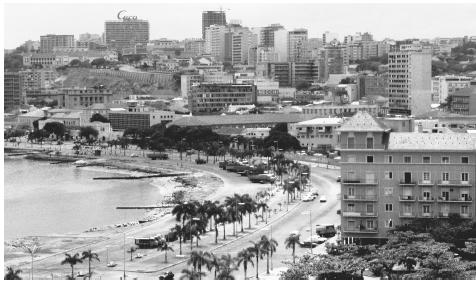
An aerial view of Angola's capital city, Luanda.
southwest rely mostly on dairy products and meat, and farmers eat maize, sorghum, cassava and other agricultural crops. Especially in urban areas but also in the drier rural areas, gathering water and firewood is often time-consuming. Salt is a highly prized product in many areas.
Food Customs at Ceremonial Occasions. Many traditional ceremonies and celebrations have disappeared or are held infrequently. If circumstances allow, at a party or ceremony, grilled chicken, soft drinks, and bottled beer are served and consumed in liberal amounts. As these items are costly, most people can only afford local beverages such as maize beer and palm wine.
Basic Economy. The farming sector has been neglected by the government. The war has made agriculture impossible in many areas, and transport is often a dangerous undertaking. Although 70 percent of the people engage in agriculture to sustain themselves, over 50 percent of the food supply has to be imported. Farmers plant gardens in which subsistence crops are grown.
Land Tenure and Property. Access to land is difficult. There is not a land shortage, but not all arable land is under cultivation. This problem is caused by the fact that war prevents farmers from going to their fields and often forces people to flee before the harvest. In times of relative calm, land mines render traveling to and working on the land dangerous. Both the MPLA and UNITA have restricted the freedom of movement of the population and imposed rules to curb mobility in specific areas or during certain parts of the day.
Commercial Activities. Small retail trade is very important in people's survival strategies. Women are especially important in selling food and firewood, and men predominate in trade in arms, diamonds, and spare parts. Most of the people who work in the transport and building sectors are men. Local commercial activities are largely situated in the extensive candonga system, the name for the second economy. The new kwanza, the national currency, is subject to high inflation rates. As the war often makes transport impossible, crafts and repair have become increasingly important again.
Major Industries. Angola is a potentially rich country. Petroleum in the Cabinda enclave; diamonds in Lunda; and iron, phosphates, copper, gold, bauxite, and uranium in the other provinces are some of the natural resources. In comparison with other sub-Saharan countries, Angola is industrialized to a considerable degree and has a relatively high income per capita. Oil (90 percent of exports) is
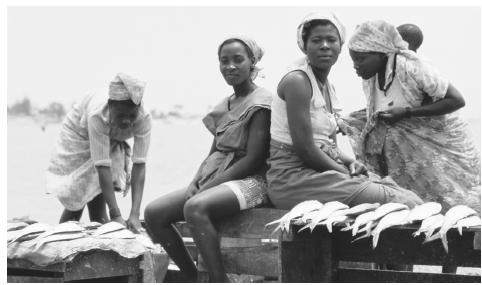
A group of women selling fish at Luanda Port. In general, Angolan women play a vital role in farming and food trading, while men are herders and wage laborers.
especially important. Most of these resources are used to finance the military, however, as Angola has a war economy. Only those who have a stake in the war benefit from this system; for most people it means hunger. UNTA (National Union of Angolan Workers), for a long time the only effective labor organization, has been important in the redirection of the economy but rarely manages to represent workers' interests adequately and is strongly connected with the government party. A rival labor organization was established in 1996.
Trade. Seventy percent of exports go to the United States, mainly crude oil, diamonds, and other natural resources. Some commercial agricultural products, such as sisal, coffee, and cotton, are sold. The fishing industry also is important. Imports come from Portugal, Brazil, the United States and the European countries and consist mainly of war equipment (50 percent) and food (20 percent). The international drug trade is growing in volume, and UNITA depends largely on the illegal diamond and arms trade.
Division of Labor. Most residents take every opportunity to make ends meet, and many historical divisions of labor have been overturned. Thus, women may clear strips of land to prepare the soil for agriculture, while men may collect and sell firewood. Generally, women are important in farming and the local food trade, while cattle herders and wage laborers are usually men.
Social Stratification
Classes and Castes. The country is divided along many lines. Before twentieth-century colonialism, the rich trading families formed a local elite that looked down on the gentio ("pagans" or "crowd"). During the colonial era, an extremely hierarchical society was created in which Portuguese rulers gave some advantages to African assimilados (assimilated people) over the great majority of indigenas (indigenous people). Although the number of assimilados was never high, they were sharply divided, mainly on regional and religious lines. These divisions are reflected in the founding of political parties and are used for propaganda purposes. Thus, UNITA has tried to denounce the MPLA as 'foreign' because of the continuing importance of whites and mestiços in the party. The UNITA leadership is often regarded as populist and opportunistic, and the northern FNLA leadership as capitalist and conservative. However, the various elites have a number of common characteristics, such as regarding wealth and expenditure as the most important indicator of class.
Symbols of Social Stratification. The display of wealth is the most important way to show a superior position in society. This display may take the form of individual material possessions such as cars, yachts, and clothing. It also is manifested in the activities people undertake: Flashy rich youths go to Luanda's expensive discos and nightclubs. Material wealth also may be expressed by acting as a patron, for example, by holding lavish parties for large groups of people and distributing gifts.
Political Life
Government. Angola is a presidential republic. Until the 1990s, the MPLA monopolized the central state, and, despite the existence of government institutions, presidential powers were extensive. The MPLA leader, Agostinho Neto, was president until his death in September 1979, after which Eduardo dos Santos took over. Since independence, the power center has been rivaled by Jonas Savimbi, the leader of UNITA. The formal government changed in 1992 from a socialist, one-party system to a multiparty, free market system. Many parties have been founded since then, apart from the MPLA and UNITA, but only the revived FNLA continues to have an impact. In April 1997, UNITA joined the government, but it was suspended in August 1998 for failing to observe the peace agreements signed in Lusaka. The parties began fighting again, and the government won considerable terrain from UNITA. UNITA has become internationally isolated, and the whereabouts of Savimbi is unclear, although UNITA continues to buy weapons through the illegal diamond trade. A number of UNITA defectors, including some in leadership functions, have formed a group called UNITA-renovada and are calling for adherence to the Lusaka protocols. The government announced elections for late 2001, but there is no guarantee that they will be held, or will be free and fair.
Leadership and Political Officials. Both in UNITA-held and government areas, political rallies are an important aspect of the political culture. These meetings usually include songs, dances, speeches, and parades. Often they show conflicting tendencies: Although they are used by politicians to bolster their position, many people criticize their leaders during these gatherings. For people from Luanda and the surrounding area, the yearly carnival in Luanda has become a political arena. For a long time, the MPLA government regarded the continuing importance of traditional leaders in local political life with suspicion, while in UNITA the role of chiefs in political life was more widely accepted.
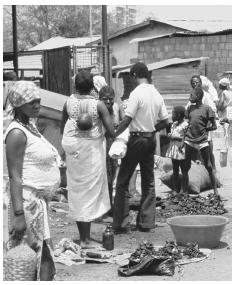
Street vendors at a market area in Luanda. Small market trade is very important to Angolan survival.
Many nongovernmental organizations (NGOs) and aid organizations rely on traditional leaders for information and channel aid through them.
Social Problems and Control. Administrative and political life is corrupt, and the bureaucracy often borders on the absurd. "Disappearance" has been the fate of many people suspected of political opposition. The armies have been accused of misbehavior, extrajudicial executions, forced enlistment, and child soldiering. The government has acted against freedom of expression and an independent press, while the Ninjas, a special police force, spread terror among the population. In UNITA areas, reports have confirmed extreme human rights abuses, such as torture, kangaroo courts, and unlawful executions. Civilians regard politics with extreme suspicion, and the continuation of the war is widely regarded as resulting from greed for power among the political leaders. It is remarkable how many people find the courage and creativity to continue living in a context of extreme violence and poverty. Nonetheless, some people do not manage: alcoholism and theft are increasing. Witchcraft is perceived by a great number of people as a problem that is not adequately addressed by politicians, the police, and the judiciary.
Military Activity. Political life is centered on the military. After independence, UNITA held the southeast and continued to hold a sway over the central highlands and Lunda Norte. Despite the ongoing war, there have been intervals of negotiation and peace. Between May 1991 and October 1992 a cease-fire was respected by both parties. After UNITA refused to accept the results of the elections held in September 1992, intense fighting broke out again. It is estimated that in the town Huambo alone, 300,000 people died during this phase of the war. In 1994 the Lusaka Protocol was signed by both parties, and in April 1997 a government of national unity and reconciliation was installed that included representatives of UNITA and MPLA. However fighting began again in 1998. Control over the diamond areas in Lunda Norte became an important war aim. The forces of the MPLA have pushed UNITA out of its former capital, Jamba, in the southeast, but fighting along the Zambian and Namibian borders has remained intense. The same situation exists in the Central Highlands, where UNITA is conducting a guerrilla war. In Cabinda, various factions of the Front for the Liberation of the Enclave of Cabinda (FLEC) have fought for secession for a long time.
Social Welfare and Change Programs
There have been attempts to implement long-term social welfare programs. In 2000, the UNDP (UN Development Program) initiated projects focusing on poverty eradication and good governance. Renewed accords with the International Monetary Fund aimed at decreasing the large national debt and reducing the inflation rate. Most of these programs focus on emergency relief. Apart from a host of NGOs, international aid organizations such as the World Food Programme, World Health Organization, UNHCR (UN High Commissioner for Refugees), UNICEF and other UN-related donors are active. With the exacerbating fighting, many people cannot be reached by these organizations, and occasionally the organizations have pulled out all their personnel as the security situation has become problematic. The rural population is hard to reach.
Nongovernmental Organizations and Other Associations
A wide range of NGOs have been active. Apart from large international emergency relief organizations, such as the Red Cross, Doctors without Borders, and CARE, a host of smaller NGOs have organized campaigns around varying issues, with varying degrees of success.
Gender Roles and Statuses
Division of Labor by Gender. The war is primarily a male affair, and few women go off to fight. Many young men have died in the war. As a consequence, a growing number of households are headed by women, and polygamy has not decreased as it has in most other African countries. The fact that the majority of the urban population is male, while women make up the larger part of the rural population, has strengthened these trends. As women are important in agriculture and the regional food trade, they run a higher risk of being hit by land mines than do civilian men. Some 80 percent of land mine victims are women and children. Rape and violence against women continue to rank as important social problems.
The Relative Status of Women and Men. Despite the MPLA's advocacy of gender equality, there are clear discrepancies between the status of women and men. The literacy rate for men is 56 percent, while only 28 percent of women were literate in 1998. Few women are in top positions in political, economic, and military affairs. Often women are paid less than men for the same jobs. The largest women's organization, the Angolan Women's Association (OMA), is strongly tied to the MPLA party. Many smaller women's organizations have been formed, often along professional lines.
Marriage, Family, and Kinship
Marriage. Marriage and cohabitation take many forms. Some couples are wed in church or by the state, others have their wedding blessed by their parents, and others do not formalize their cohabitation with a ceremony. In most cultures a couple find a home of their own or live with their husband's parents. In some areas there is a high divorce rate that not only is due to the war but also conforms to older patterns of marriage and separation. Many spouses live apart for considerable periods of time; often the economic situation is so desperate that they have to look for means of subsistence on their own. Women often are widowed and as there are more women than men of marriageable age, there is a relatively high number of polygamous households. The age gap between spouses is growing, especially in rural areas.
Domestic Unit. Many households have been disrupted by the war; a considerable number of people have seen relatives die, and communities have been destroyed by the ongoing fighting. People may have relatives in different fighting camps and often live very far from each other, and many Angolans are looking for lost relatives. Especially in rural areas, the extended family remains important: An income may be shared with one or more unemployed relatives; immigrants look for housing, land, and basic assistance from their relatives; and several generations and nuclear families may form a single household. In towns, the importance of the extended family is diminishing.
Inheritance. In most Angolan societies, inheritance is patrilineal, with children inheriting from the father. In quite a few communities among the Umbundu, Ngangela, and Ambo, property traditionally was passed to the children of the deceased's wife's brother. This matrilineal system has decreased in importance under the influence of colonialism and the war.
Kin Groups. Kinship terminology in many communities is difficult to translate. The children of uncles and aunts may be addressed with the same term used for brothers and sisters. However, there is a sharp distinction between senior and junior "brothers" and "sisters" and uncles and aunts may be differentiated in the maternal and paternal lines. In some cultures a village consists of matrilineal kin and their dependents. As many communities have been torn apart by the war, these structures have often disappeared.
Socialization
Infant Care. Young children are most likely to be taken care of by the mother and may be strapped into a cloth on her back while she engages in household chores, agricultural work, or selling at the local market. Other relatives may be equally important in a child's upbringing. Thus, children may stay with their grandparents for considerable periods of time and, especially when they are older, spend a great deal of time with the father or mother's brother's family.
Child Rearing and Education. Many children are unable to attend school because of the war, but there has been growth in the literacy rate. In 1970, 12 percent of the population was literate, while the literacy rate currently is approaching 50 percent. The majority of these people are young, reflecting government efforts to develop free educational facilities for all children. There is a lack of educational materials, qualified teachers, and school buildings. In some cultures children are initiated. Sometimes these puberty rites concern only boys, but in groups such as the Nyanyeka, girls are also initiated. In most communities, the rites have shortened considerably or disappeared. Poverty and the war have caused the number of street children and orphans to grow.
Higher Education. There are two universities. The older university, named after the country's first president, is in Luanda, with branches in Huambo and Lubango. As a result of the war, the Huambo branch has been closed down repeatedly, and the university is poorly equipped, badly housed, and overcrowded. A Catholic university opened in 1999 in Luanda.
Etiquette
In general, dress codes are not strict. In some areas, women are supposed to wear long-hemmed skirts, but this rule is not strictly applied. In many communities, people do not look each other in the eye while speaking. Younger people are expected to address elders politely. The ability to speak well is a highly admired trait, in both men and women. In some communities, men do not eat with women and children.
Religion
Religious Beliefs. Especially in the coastal regions, Christianity dates back a long time. A Christian church was established in the Kongo region by the end of the fifteenth century. It is unclear how many residents are Christian; the Roman Catholic Church figures range from 38 percent to 68 percent. Another 15 to 20 percent belong to Protestant denominations, such as Methodist, Baptist, and African churches. For many people there is no contradiction between Christian faith and aspects of African religions. Thus, religious specialists such as diviners and healers hold an important position in society. The government, with its socialist outlook, has been in frequent conflict with religious leaders. Because the Roman Catholic Church has great influence and was associated with Portuguese colonialism, relations with that faith have been especially tense. Since the move toward a more liberal political system, relations with the established churches have eased considerably, although troubling incidents continue to occur. An unknown number of residents do not profess any religion.
Religious Practitioners. Traditional healers and diviners have been disregarded by the socialist government. Although the role of these religious practitioners in the community often increased during
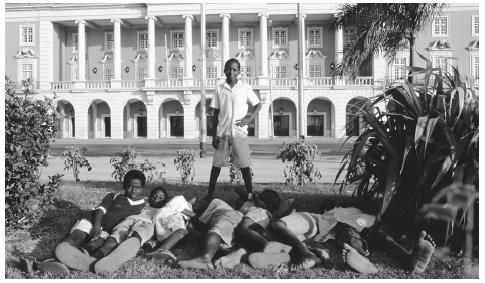
Street children in Luanda. Poverty and war have caused the number of orphaned and homeless Angolan children to grow at a rapid rate.
the war, the MPLA refused to recognize their function, and at times they were hindered in the execution of their profession. In UNITA areas, the function of healers and diviners has been acknowledged to a far greater extent. There are widespread accusations, however, that UNITA has used healers and diviners to intimidate civilians under their control.
Rituals and Holy Places. Because of the war, many religious practices have been discontinued and cultural institutions are no longer in use. Amid the chaos of the war, many formerly meaningful places and activities have lost their function. Under the influence of the churches, a number of traditional African religious practices have disappeared. In the war context, people attempt to find new ways to address the critical situation. Thus, malign spirits are exorcised in newly established independent churches, children wear amulets to prevent being forced into the army during round-ups, and soldiers strictly follow all the rules given them to make a magic potion against bullets.
Death and the Afterlife. In many Angolan societies, a funeral is an extremely important event; mourning rituals often are regarded as essential for the peace of the deceased's soul. Because of the war, there is often no opportunity to carry out the appropriate rituals for the dead. Although people have sought alternative forms of mourning, war victims sometimes are left unburied. Apart from the personal trauma this may involve, many people fear that restless spirits will further disrupt social life.
Medicine and Health Care
Despite government efforts to extend basic health care services, most people do not have access to medical assistance. Many hospitals face an extreme lack of personnel and do not have the most basic equipment. Only a tiny minority of the population can afford good medical care. For the majority of people, life expectancy is below fifty years. Poverty-related diseases such as cholera, tuberculosis, and measles are a problem in overcrowded urban areas and refugee camps. Many deaths are a direct consequence of malnutrition and undernourishment. The number of people with AIDS is increasing; malaria is common in some areas, especially during the rainy season. One in three children dies before reaching his or her fifth birthday. Angola is one of the few countries where maternal mortality is increasing. A number of health problems are a direct consequence of the war. Over 10 million land mines
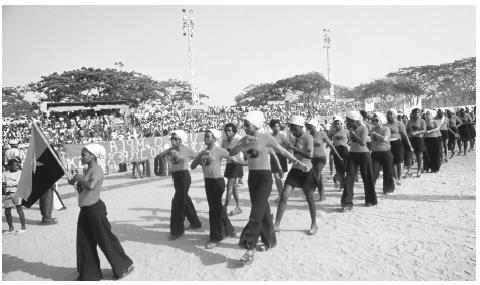
A march to celebrate the 1961 war for liberation, held in a stadium in Luanda, in 1975.
have resulted in the highest number of amputees in the world, mental illnesses are often related to war trauma, and many children and elderly people have been left without support. With basic health care in disarray, many people seek help from traditional healers. These medical-religious specialists often deal with psychological problems, and many have extensive knowledge of herbal remedies.
Secular Celebrations
On 11 November 1975 Angola became an independent country. This day is celebrated every year. Apart from Christian holidays, a wide range of occasions are commemorated, such as the founding of the MPLA, the beginning of the armed struggle, and the anniversary of Neto.
The Arts and Humanities
Literature. Angola has an outstanding literary tradition. An important genre has been political poetry, of which the former president Agostinho Neto was a significant representative. The arts, relatively free from censorship, have been an important way to express criticism of the political system. Oral literature is important in many communities, including mermaids in Luandan lore, Ovimbundu trickster tales, and sand graphs and their explication in the east.
The press has been largely controlled by the MPLA and UNITA. Journalists who express alternative views have been curbed in the exercise of their profession: Murder, censorship, and accusations of defamation have been used to suppress an independent press. Radio constitutes an important source of information, but has been dominated by belligerent parties for a long time; although, a Catholic radio station, Rádio Ecclésia, has been established.
Graphic Arts. Crafts such as wood carving and pottery are sold in neighboring countries. Luanda has a number of museums, including the Museum of Anthropology.
Performance Arts. Angolan music, with its ties to Brazil, has received international attention. The most popular spectator sports are soccer and basketball.
The State of the Physical and Social Sciences
Academics face many problems, and the state university is short on staff and teaching materials. As a result of the war, Angola is severely underrepresented in research: Many themes cannot be addressed, many sources have been destroyed, and many areas cannot be reached by researchers. There are well-stocked libraries in Luanda as well as a national archive.
Bibliography
Birmingham, David. Frontline Nationalism in Angola and Mozambique, 1992.
Bridgland, Fred. Jonas Savimbi: A Key to Africa, 1987.
Davidson, Basil. In the Eye of the Storm: Angola's People, 1972.
Hare, Paul. Angola's Last Best Chance for Peace: An Insider's Account of the Peace Process, 1998.
Hart, Keith, and Joanna Lewis, eds. Why Angola Matters, 1995.
Heywood, Linda. Contested Power in Angola, 1840s to the Present, 2000.
Kapuscinski, Ryszard. Another Day of Life, 1988.
Maier, Karl. Angola: Promises and Lies, 1996.
Marcum, John A. The Angolan Revolution, Vols. I and II, 1969, 1978.
Miller, Joseph C. Way of Death: Merchant Capitalism and the Angolan Slave Trade, 1730–1830, 1988.
Neto, Agostinho. Sacred Hope, 1974.
Pepetela. Yaka, 1996.
Wheeler, Douglas L., and René Pélissier. Angola, 1971.
Wolfers, Michael, and Jane Bergerol. Angola in the Frontline, 1983.
